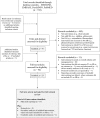Theory-informed interventions to promote physical activity and reduce sedentary behaviour in rheumatoid arthritis: a critical review of the literature
- PMID: 32411931
- PMCID: PMC7219651
- DOI: 10.31138/mjr.31.1.19
Theory-informed interventions to promote physical activity and reduce sedentary behaviour in rheumatoid arthritis: a critical review of the literature
Abstract
Moderate-intensity physical activity (PA) is recommended for the management of Rheumatoid Arthritis (RA). Recent evidence suggests that reducing sedentary behaviour (promoting 'sedentary breaks' and light intensity PA) may also offer potential for improving RA outcomes, independently of the benefits of moderate-intensity PA. Unfortunately, people living with RA engage in very little moderate-intensity PA, and the spend the majority of the day sedentary. Interventions to support PA and sedentary behaviour change in this population are therefore required. Psychological theory can provide a basis for the development and implementation of intervention strategies, and specify the cognitive processes or mechanisms assumed to result in behavioural change. Application of psychological theory to intervention development and evaluation, therefore, permits evaluation of "how things work", helping to identify optimal intervention strategies, and eliminate ineffective components. In this review, we provide an overview of existing PA and sedentary behaviour change interventions in RA, illustrating the extent to which current interventions have been informed by psychological theories of behaviour change. Recommendations are provided for future interventional research in this domain, serving as a reference point to encourage proper application of behavioural theories into intervention design, implementation and appraisal.
Keywords: behaviour change; physical activity; rheumatoid arthritis; sedentary behaviour; theory.
© 2020 The Mediterranean Journal of Rheumatology (MJR).
Figures

 , delivery
, delivery  and evaluation
and evaluation  . Guiding frameworks are shown as
. Guiding frameworks are shown as 

References
-
- Metsios GS, Stavropoulos-Kalinoglou A, Kitas GD. The role of exercise in the management of rheumatoid arthritis. Expert Rev Clin Immunol 2015;11(10):1121–30. - PubMed
-
- Agca R, Heslinga SC, Rollefstad S, Heslinga M, McInnes IB, Peters MJ, et al. EULAR recommendations for cardiovascular disease risk management in patients with rheumatoid arthritis and other forms of inflammatory joint disorders: 2015/2016 update. Ann Rheum Dis 2017;76(1):17–28. - PubMed
-
- Fenton SA, Veldhuijzen van Zanten JJ, Kitas GD, Duda JL, Rouse PC, Yu CA, et al. Sedentary behaviour is associated with increased long-term cardiovascular risk in patients with rheumatoid arthritis independently of moderate-to-vigorous physical activity. BMC Musculoskelet Disord 2017;18(1):131. - PMC - PubMed
-
- Fenton SAM, Sandoo A, Metsios GS, Duda JL, Kitas GD, Veldhuijzen van Zanten J. Sitting time is negatively related to microvascular endothelium-dependent function in rheumatoid arthritis. Microvasc Res 2018;117:57–60. - PubMed
Publication types
LinkOut - more resources
Full Text Sources
